
Welcome, from sunny Australia!
The Stock 4AGE Description Page - Oil systems, etc

The Stock 4AGE Description Page - Oil systems, etc
4AGE Oil system
The 4AGE oil system is excellent, and gives
little trouble. There are three types of oil pump gears, and I have yet
to find a way of reliably finding out which is which from any external
markings. Two types of those gears are shown below, with the third type
being much the same as the one on the right, just the gear tooth
spacing is a little wider and so the teeth are 'squarer'. Some front
engine covers have 'AISIN S1' on the front, some have 'AISIN S2', and
some have none. There seems to be a bit of a general trend though, with
the small one is to be found on the three rib blocks, and the big one
on all of the others, including the 4AGZE & 20v.
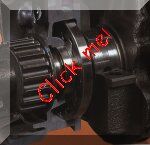
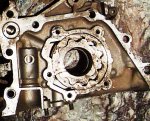 |
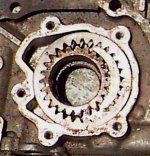 |
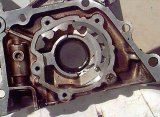 |
The oil system is otherwise unconventional, though when a RWD car is cornering very hard it will occasionally suffer from surge and also sometimes on fast left hand corners blow a LOT of oil into the inlet manifold through the cam cover breather. (I've had this happen acouple of times - Thought the engine had blown with the amount of smoke coming out!)
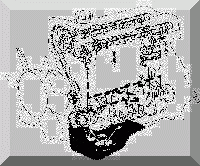
Between the sump and the block sits a
windage tray, and by all reports it's a good thing to leave it in
place, unmodified.
One thing that I may advise is to use a full
synthetic oil exclusively in the engine - I have tried mineral oils,
and they make the engine very hard to start in cold weather. The other
area of the 4AGE that is very good is the genuine Toyota oil filters -
Use no other! They cost a bit more than aftermarket brands, but are muchbetter
in filtering and low restriction. If you think you need more filter
area than the stock filter provides, the UZ series engine oil filter
will fit and have about 48% more internal volume than the stock 4AGE
filter.
4AGE Water system
The water system is also excellent, but must
be kept in good condition to ensure that no problems arise. There are
differences between the FWD and RWD engines though, with the RWD being
basically exactly the same as the single cam RWD 4AC, so the 4AC is a good source to
get bits for to convert FWD engines to RWD.
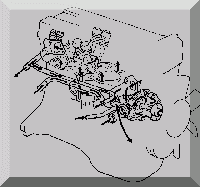
The RWD engine has the thermostat system
up the front, whilst the FWD has all that hanging off the back of the
head. This makes converting a FWD engine to a RWD a bit tricky unless
you have the RWD parts, but they all are a straight bolt-on part so if
you can source them it's not difficult at all to do. Read Phil
Bradshaw's excellent page on how to do all this.
Both types of engine have the water system
working the same way as each other, but back to front to a normal
engine. The 4AGE's have the water on a cold start-up circulating around
the block until it warms up because the thermostat will not let any
other cold water in, unlike a 'normal' system, where the thermostat
keeps the water in by blocking the outlet.
What this means is that you must
keep
the water level high, and the system free of all air bubbles.
It also means that the water system will
tend to give you little or no warning that something is wrong - It'll
keep the temperature perfectly normal until it's nearly out of water,
then one minute the temperature is fine, the next it's off into the red
... As I said, make very sure that it's in good condition.
There are two sorts of water pumps for the
16v n/a engines - (not sure about the 4AGZE or the 20v, but I'd guess
they're identical to the FWD 16v) The RWD pump is the same as the
single cam 4AC, and is about 6mm longer than the FWD water pump. It
also has a longer shaft sticking out the front, and this is to locate
the cooling fan for the radiator. The FWD pumps don't have a fan
hanging off the front of them, so they only have a stub shaft to
locate the fanbelt pulley.
They are NOT interchangeable! - I found this
out when I tried to use - through ignorance - a FWD pump on my RWD
AE-86. I found that at 5400rpm, with the fan bolted on, there developed
a harmonic vibration that pulled the fan, fan flange, and front half of
the water pump clean off the front of the engine!! It also cracked in
half the water pump housing, and the fan also did a good job grinding
into the back of the radiator ...
FWIW, the FWD and RWD pulleys are also that
same 6mm difference in offset, so the difference should be obvious if
you make a mistake.
The radiator is also excellent, and is quite
capable of taking a lot of heat through it - They're used dead stock in
Group A racing cars. It is a single row unit, and has plastic top &
bottom tanks. It is good for about ten years use before needing
re-coring or replacement. If you are desperate for more cooling,
however, there is a rare twin-row radiator available for them. I'm not
sure what car they come from but I think it's an automatic gearbox one
of some sort, as I have that radiator in my car and it has two small
fittings for an oil cooler in the lower tank.
4AGE EFI system
The 4AGE computer is quite reliable and
efficient, and each engine type has its own type of computer. Note that
if you find a computer with the same type of connector plug, then the
engine will also run just fine with the new computer, sometimes better,
sometimes worse! (eg, fitting a small port computer to a TVIS big port
engine and making the TVIS stay open will often make the engine go
better at higher revs, but worse at low revs)
The computers have a few inputs -
- RPM, by means of two signal generators in
the distributor
- Throttle closed and throttle position (for
the idle & accelerator pump functions)
- Inlet manifold or Air Flow (meter) as
appropriate
- Inlet air temperature
- Water temperature
- Oxygen sensor feedback
- Knock sensor (some engines)
From these inputs, it crunches some numbers,
and outputs to -
- Fuel injectors
- Ignition coil, for spark timing
- Supercharger on/off (on 4AGZE only, of
course)
- TVIS on/off (on big ports only)
- VVT on/off (20v only)
Apart from a relatively conventional
cold-start warm-up, the 4AGE computer has just two modes of operation -
open and closed loop. In closed loop mode, the computer uses the
oxygen sensor to 'look' at the fuel/air mixture ratio, and it then
adjusts the fuel injector output to give the optimum fuel/air ratio. It
does this thousands of times per second, and is only limited to the
speed of which the oxygen sensor can react to new fuel/air ratios.
The other mode of operation, open loop,
occurs when you give the engine full throttle. In this mode, the
computer ignores the oxygen sensor signal and simply reverts to a
pre-set map for the injector output.
What this means is that you can actually
make a fair few changes to the engine and the computer will learn to
compensate for them, but only as long as you're at part throttle. As
soon as you go to full throttle, the computer goes to the
pre-programmed mode, and so may well run too lean. All this is quite
easily fixeable by using higher fuel pressures, bigger injectors, etc.
One oddity of the standard EFI computer (big
port only?) is
that below 6,000rpm it uses two injector pulses per engine revolution,
(it's not a 'sequential' type of computer) and above that a single,
longer pulse.
Another oddity is the way that the 'cold
start injector' works - It's not controlled by the computer at all, but
in fact by a thermal switch at the back of the head. The injector in
question sits in the middle of the inlet manifold, on the lower half of
the inlet plenum.
The TVIS engines all use a 'single pintle'
or as I call it a 'single squirter' type of injector, while the rest
use a much better 'twin pintle' injector. These have two injection
holes, and they are aimed at each inlet valve rather than the single
squirter pointing straight at the port divider in the head.
The TVIS and 20v engines also have a simple
rpm activated switch that operates the TVIS/VVT systems. As far as I
know, at 4,400rpm on both types each system is commanded to operate.
The later model 'Blacktop' 20v is a little smarter in that it works the
VVT mechanism from inputs from water temp, throttle position, rpm, etc.
The 4AGZE is a little different, as the
supercharger is turned on & off by a small logic program in the
computer that looks at manifold pressure and time. (see www.mr2.com for more details)
The fuel pressure from the factory pump is
about 75psi, and is regulated down to about 35psi - 38psi at the fuel
rail. The fuel rail has the pressure regulator on the outlet end, and a
pressure damper on the other. The damper takes the 'bumps' out the
fuel pressure delivery, thus keeping the fuel pressure more constant.
Here are the various fuel injector sizes (for Japanese engines, other countries may vary) -
| TVIS big port | 182cc/min |
| Small port | 235cc/min |
| 4AGZE | 365cc/min |
| 20v | 295cc/min |
There's a few sites that have information
on error codes and computer box pin-outs, etc. I won't bother
duplicating them, so here they are -
Paul
Pyyvaara's site , which has the error codes for some 4AGE's.
Phil
Bradshaw's site , which has pin-outs for most 4AGE computer boxes.
Matti
Kalalahti's site , which has the pinouts for most Toyota computer boxes.
Club4AG
, which has a great deal of good technical info of all sorts on it.
One last important item is the small rubber pipe that goes from the inlet manifold to the fuel pressure regulator. What it does is this - When there's a high vacuum, as you get at idle, it alters the regulator so that it has a little less pressure. When you open the throttle, the manifold pressure quickly rises a little, and as a result the fuel pressure also rises a little, thus making a cheap & effective accelerator pump. The engine will work just fine without that rubber pipe though.
4AGE other stuff
Flywheels &
clutches
The flywheels on all the 4AGE's are held on
with eight extremely high quality bolts. They are fine for all amounts
of power. The AE-86 flywheel is a little smaller than the others, and
so is the clutch assembly. In fact the clutch on the AE-86's 4AGE is
exactly the same as the single cam 4AC. Not entirely sure if that's a
good thing, but it seems to last okay and makes it pretty cheap &
easy to get new ones. FWIW, I think that the 3TGTE clutch assembly
should bolt straight on, and if so, it would be a good thing as they
can take 160ft-lbs of torque - A lot more than the 4AGE clutch is
designed for.
The other 4AGE's have a flywheel &
clutch that is about 12mm larger in diameter, and so they are not
interchangeable with the AE-86 unit.
I have heard that there is a very early FWD
4AGE that has black lettering on the cam cover, and this engine has
only six bolts on the crank to flywheel. This means the crankshaft should be indentical to the single-cam 4AC.
Starters
As far as I know, they're all
interchangeable, and there are two types - A straight electric starter
and a reduction type. The reduction type weighs a little less, spins
the engine better, and is a lot harder to find at the wreckers yard. There are kits available that allow you to fit a 1GGE
starter (the 2 litre 6 cylinder Toyota engine) to the 4AGE, but they
are rare outside Japan. The exhaust manifold must be removed to get the
starter on and off.
Alternators
Not much to know - Just your average
Japanese unit with an internal voltage regulator. About 50amps output
and there are slight differences between the 16v and 20v types.
20 valve VVT
Controller
What the VVT controller does is alter the
inlet cam timing so that the
engine makes more power at low revs than it otherwise would, and the
same at higher revs. The VVT controller is only fitted to the 20v, and
cannot be retrofitted to any other 4AG(Z)E.
See my 'VVT Vs VTEC
' page for full details on how it all works.
The logic that controls the VVT comes in three types for the 20
valve. To the best of my knowledge, silvertop 20v's pre May 1993
have the VVT actuate at about 4400rpm. Post May 1993 they seem to work
on throttle position and ignore revs.
The blacktops seem to work like this, as
described on Club4AG -
1. Starting. When you crank the starter there will be VVT operation
until the engine fires up, obviously to allow more air into the
engine to allow an easier fire up.
2. Coolant temp. There is absolutely NO VVT operation when the
coolant tempt is below 50c except for that brief moment when you
operate the starter. Reason obvious, who want to stress a cold engine.
3. Engine rpm. VVT will operate in any rpm between the range of 1500
and 7200 when the inlet manifold pressure is right. The min and max
range can be a little out because I was reading from the car tacho.
Trust me they are very close.
4. Engine load/inlet manifold pressure. This seems to be the single
most important parameter controling the system. The VVT will NOT
operate if the inlet manifold has more than about 5 inches of vacuum
(can't get the exact reading because everything happen so fast. It's
very close.). This is very close to zero vacuum which is atmospheric
and that is about the maximum load the map sensor will read to tell
the engine in an NA car. As you can figure out the throttle will
usually be in the more than 3/4 position for this to happen.
5. VVT will work without the speed sensor.
4AGZE superchargers
The blower on the 4AGZE has a pulley with an
electronic clutch on the front, just like an air conditioner compressor
so it can be turned on & off as the computer thinks it's needed.
They are limited to the amount of boost they can make, and this is a
function of the tip speed of the rotors rather than the actual boost
made by the blower. (but by the nature of the beast, this is much the
same sort of thing anyway) They also don't like being run all the time,
so if you have plans of making the clutch stay on all the time, then
the blower will fail prematurely.
They have their own small oil supply, and so
are self contained.
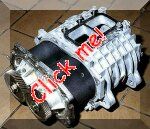
There are some slight differences between
the various blowers, but not enough to warrant searching for another
one - The pulley sizes are slightly different with various versions of
the 4AGZE, but to get a significant improvement you'd be best simply
going for something like the HKS kit, which makes the blower spin a
fair bit faster (not so fast as to endanger the teflon rotor tips,
though) and so take the engine up to about 180 - 200hp.
For what it's worth, a 1GGZE supercharger
will not bolt onto a 4AGZE engine as such, but wth mods to the mounting
brakets they can be made to fit. A new inlet manifold is usually needed
as well - This is a good thing, as the factory 4AGZE inlet manifold is
rather poor.
Through various devious means, a 20v
blacktop service manual was copied and placed on the net with the help
of a few friends. It can be found here . The
Adobe *.pdf reader is required to look at the files.
 |
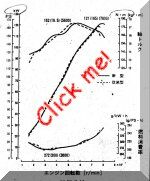 |
 |
These tables are of interest - The one on
the left is the stock head flow figures for a small port 16v and a
silvertop 20v head at 10" of water. You can see that the 20v head flows
more quite comfortably. In the middle is the official Toyota power
figures for the silver & blacktop 20 valve engines, and you can see
that they're quite similar. However, when tested on an accurate engine
dyno, the table on the right shows that they are somewhat less powerful
than what Toyota tells us. The blacktops make about 148hp or 110kW.
Back to the Index page
Page & contents where applicable © Bill Sherwood